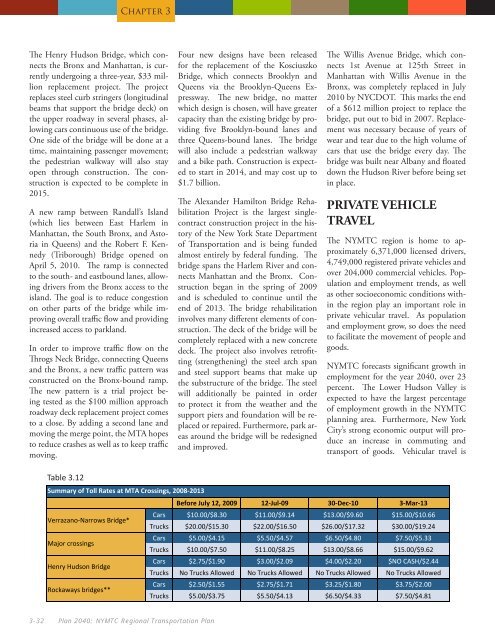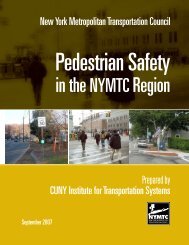Chapter 3 The Transportation System - New York Metropolitan ...
Chapter 3 The Transportation System - New York Metropolitan ...
Chapter 3 The Transportation System - New York Metropolitan ...
- No tags were found...
You also want an ePaper? Increase the reach of your titles
YUMPU automatically turns print PDFs into web optimized ePapers that Google loves.
<strong>Chapter</strong> 3<strong>The</strong> Henry Hudson Bridge, which connectsthe Bronx and Manhattan, is currentlyundergoing a three-year, $33 millionreplacement project. <strong>The</strong> projectreplaces steel curb stringers (longitudinalbeams that support the bridge deck) onthe upper roadway in several phases, allowingcars continuous use of the bridge.One side of the bridge will be done at atime, maintaining passenger movement;the pedestrian walkway will also stayopen through construction. <strong>The</strong> constructionis expected to be complete in2015.A new ramp between Randall’s Island(which lies between East Harlem inManhattan, the South Bronx, and Astoriain Queens) and the Robert F. Kennedy(Triborough) Bridge opened onApril 5, 2010. <strong>The</strong> ramp is connectedto the south- and eastbound lanes, allowingdrivers from the Bronx access to theisland. <strong>The</strong> goal is to reduce congestionon other parts of the bridge while improvingoverall traffic flow and providingincreased access to parkland.In order to improve traffic flow on theThrogs Neck Bridge, connecting Queensand the Bronx, a new traffic pattern wasconstructed on the Bronx-bound ramp.<strong>The</strong> new pattern is a trial project beingtested as the $100 million approachroadway deck replacement project comesto a close. By adding a second lane andmoving the merge point, the MTA hopesto reduce crashes as well as to keep trafficmoving.Four new designs have been releasedfor the replacement of the KosciuszkoBridge, which connects Brooklyn andQueens via the Brooklyn-Queens Expressway.<strong>The</strong> new bridge, no matterwhich design is chosen, will have greatercapacity than the existing bridge by providingfive Brooklyn-bound lanes andthree Queens-bound lanes. <strong>The</strong> bridgewill also include a pedestrian walkwayand a bike path. Construction is expectedto start in 2014, and may cost up to$1.7 billion.<strong>The</strong> Alexander Hamilton Bridge RehabilitationProject is the largest singlecontractconstruction project in the historyof the <strong>New</strong> <strong>York</strong> State Departmentof <strong>Transportation</strong> and is being fundedalmost entirely by federal funding. <strong>The</strong>bridge spans the Harlem River and connectsManhattan and the Bronx. Constructionbegan in the spring of 2009and is scheduled to continue until theend of 2013. <strong>The</strong> bridge rehabilitationinvolves many different elements of construction.<strong>The</strong> deck of the bridge will becompletely replaced with a new concretedeck. <strong>The</strong> project also involves retrofitting(strengthening) the steel arch spanand steel support beams that make upthe substructure of the bridge. <strong>The</strong> steelwill additionally be painted in orderto protect it from the weather and thesupport piers and foundation will be replacedor repaired. Furthermore, park areasaround the bridge will be redesignedand improved.<strong>The</strong> Willis Avenue Bridge, which connects1st Avenue at 125th Street inManhattan with Willis Avenue in theBronx, was completely replaced in July2010 by NYCDOT. This marks the endof a $612 million project to replace thebridge, put out to bid in 2007. Replacementwas necessary because of years ofwear and tear due to the high volume ofcars that use the bridge every day. <strong>The</strong>bridge was built near Albany and floateddown the Hudson River before being setin place.PRIVATE VEHICLETRAVEL<strong>The</strong> NYMTC region is home to approximately6,371,000 licensed drivers,4,749,000 registered private vehicles andover 204,000 commercial vehicles. Populationand employment trends, as wellas other socioeconomic conditions withinthe region play an important role inprivate vehicular travel. As populationand employment grow, so does the needto facilitate the movement of people andgoods.NYMTC forecasts significant growth inemployment for the year 2040, over 23percent. <strong>The</strong> Lower Hudson Valley isexpected to have the largest percentageof employment growth in the NYMTCplanning area. Furthermore, <strong>New</strong> <strong>York</strong>City’s strong economic output will producean increase in commuting andtransport of goods. Vehicular travel isTable 3.12Summary of Toll Rates at MTA Crossings, 2008‐2013Before July 12, 2009 12‐Jul‐09 30‐Dec‐10 3‐Mar‐13Verrazano‐Narrows Bridge*Major crossingsHenry Hudson BridgeRockaways bridges**CarsCarsCarsCars$10.00/$8.30$5.00/$4.15$2.75/$1.90$2.50/$1.55$11.00/$9.14$5.50/$4.57$3.00/$2.09$2.75/$1.71$13.00/$9.60$6.50/$4.80$4.00/$2.20$3.25/$1.80$15.00/$10.66$7.50/$5.33$NO CASH/$2.44$3.75/$2.00TrucksTrucksTrucksTrucks$20.00/$15.30$10.00/$7.50No Trucks Allowed$5.00/$3.75$22.00/$16.50$11.00/$8.25No Trucks Allowed$5.50/$4.13$26.00/$17.32$13.00/$8.66No Trucks Allowed$6.50/$4.33$30.00/$19.24$15.00/$9.62No Trucks Allowed$7.50/$4.813-32 Plan 2040: NYMTC Regional <strong>Transportation</strong> Plan
















